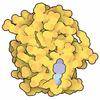Entry Database : PDB / ID : 1zduTitle The Crystal Structure of Human Liver Receptor Homologue-1 Nuclear receptor coactivator 2 Orphan nuclear receptor NR5A2 Keywords / / / / / Function / homology Function Domain/homology Component
/ / / / / / / / / / / / / / / / / / / / / / / / / / / / / / / / / / / / / / / / / / / / / / / / / / / / / / / / / / / / / / / / / / / / / / / / / / / / / / / / / / / / / / / / / / / / / / / / / / / / / / / / / / / / / / / / / / / / / / / / / / / / / / / / / / / / / / / / / / / / / / / / / / / / / / / / / / / / / / / / / Biological species Homo sapiens (human)Method / / / Resolution : 2.5 Å Authors Wang, W. / Zhang, C. / Marimuthu, A. / Krupka, H.I. / Tabrizizad, M. / Shelloe, R. / Mehra, U. / Eng, K. / Nguyen, H. / Settachatgul, C. ...Wang, W. / Zhang, C. / Marimuthu, A. / Krupka, H.I. / Tabrizizad, M. / Shelloe, R. / Mehra, U. / Eng, K. / Nguyen, H. / Settachatgul, C. / Powell, B. / Milburn, M.V. / West, B.L. Journal : Proc.Natl.Acad.Sci.USA / Year : 2005Title : The crystal structures of human steroidogenic factor-1 and liver receptor homologue-1Authors : Wang, W. / Zhang, C. / Marimuthu, A. / Krupka, H.I. / Tabrizizad, M. / Shelloe, R. / Mehra, U. / Eng, K. / Nguyen, H. / Settachatgul, C. / Powell, B. / Milburn, M.V. / West, B.L. History Deposition Apr 14, 2005 Deposition site / Processing site Revision 1.0 May 24, 2005 Provider / Type Revision 1.1 Apr 30, 2008 Group Revision 1.2 Jul 13, 2011 Group / Version format complianceRevision 1.3 Feb 14, 2024 Group / Database references / Derived calculationsCategory chem_comp_atom / chem_comp_bond ... chem_comp_atom / chem_comp_bond / database_2 / struct_site Item _database_2.pdbx_DOI / _database_2.pdbx_database_accession ... _database_2.pdbx_DOI / _database_2.pdbx_database_accession / _struct_site.pdbx_auth_asym_id / _struct_site.pdbx_auth_comp_id / _struct_site.pdbx_auth_seq_id
Show all Show less
 Open data
Open data Basic information
Basic information Components
Components Keywords
Keywords Function and homology information
Function and homology information Homo sapiens (human)
Homo sapiens (human) X-RAY DIFFRACTION /
X-RAY DIFFRACTION /  SYNCHROTRON /
SYNCHROTRON /  MOLECULAR REPLACEMENT / Resolution: 2.5 Å
MOLECULAR REPLACEMENT / Resolution: 2.5 Å  Authors
Authors Citation
Citation Journal: Proc.Natl.Acad.Sci.USA / Year: 2005
Journal: Proc.Natl.Acad.Sci.USA / Year: 2005 Structure visualization
Structure visualization Molmil
Molmil Jmol/JSmol
Jmol/JSmol Downloads & links
Downloads & links Download
Download 1zdu.cif.gz
1zdu.cif.gz PDBx/mmCIF format
PDBx/mmCIF format pdb1zdu.ent.gz
pdb1zdu.ent.gz PDB format
PDB format 1zdu.json.gz
1zdu.json.gz PDBx/mmJSON format
PDBx/mmJSON format Other downloads
Other downloads 1zdu_validation.pdf.gz
1zdu_validation.pdf.gz wwPDB validaton report
wwPDB validaton report 1zdu_full_validation.pdf.gz
1zdu_full_validation.pdf.gz 1zdu_validation.xml.gz
1zdu_validation.xml.gz 1zdu_validation.cif.gz
1zdu_validation.cif.gz https://data.pdbj.org/pub/pdb/validation_reports/zd/1zdu
https://data.pdbj.org/pub/pdb/validation_reports/zd/1zdu ftp://data.pdbj.org/pub/pdb/validation_reports/zd/1zdu
ftp://data.pdbj.org/pub/pdb/validation_reports/zd/1zdu Links
Links Assembly
Assembly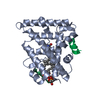
 Components
Components Homo sapiens (human) / Production host:
Homo sapiens (human) / Production host: 
 X-RAY DIFFRACTION / Number of used crystals: 1
X-RAY DIFFRACTION / Number of used crystals: 1  Sample preparation
Sample preparation SYNCHROTRON / Site:
SYNCHROTRON / Site:  ALS
ALS  / Beamline: 8.3.1 / Wavelength: 1.11587 Å
/ Beamline: 8.3.1 / Wavelength: 1.11587 Å Processing
Processing MOLECULAR REPLACEMENT / Resolution: 2.5→50 Å / Cor.coef. Fo:Fc: 0.937 / Cor.coef. Fo:Fc free: 0.924 / SU B: 12.874 / SU ML: 0.272 / TLS residual ADP flag: LIKELY RESIDUAL / Cross valid method: THROUGHOUT / σ(F): 0 / σ(I): 0 / ESU R: 0.603 / ESU R Free: 0.32 / Stereochemistry target values: MAXIMUM LIKELIHOOD / Details: HYDROGENS HAVE BEEN ADDED IN THE RIDING POSITIONS
MOLECULAR REPLACEMENT / Resolution: 2.5→50 Å / Cor.coef. Fo:Fc: 0.937 / Cor.coef. Fo:Fc free: 0.924 / SU B: 12.874 / SU ML: 0.272 / TLS residual ADP flag: LIKELY RESIDUAL / Cross valid method: THROUGHOUT / σ(F): 0 / σ(I): 0 / ESU R: 0.603 / ESU R Free: 0.32 / Stereochemistry target values: MAXIMUM LIKELIHOOD / Details: HYDROGENS HAVE BEEN ADDED IN THE RIDING POSITIONS Movie
Movie Controller
Controller



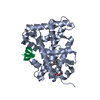


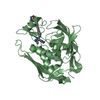

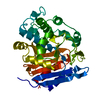





 PDBj
PDBj


